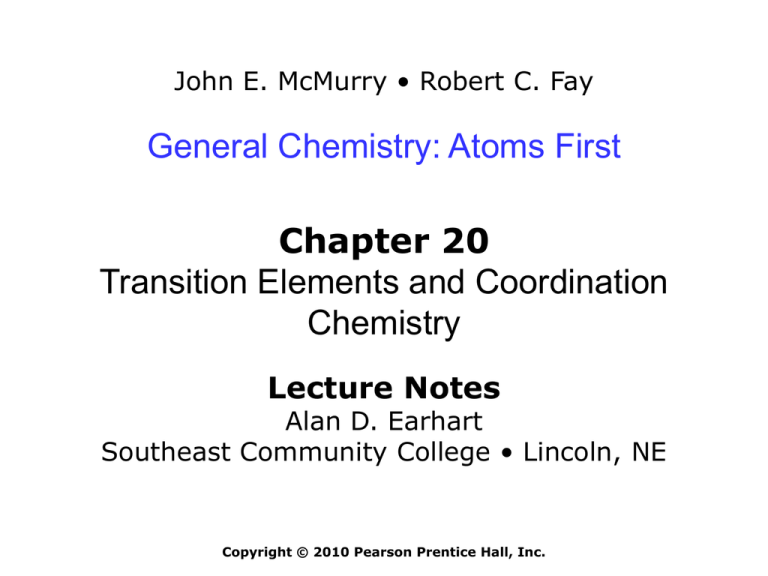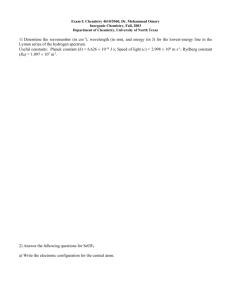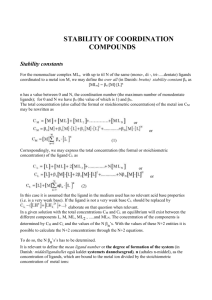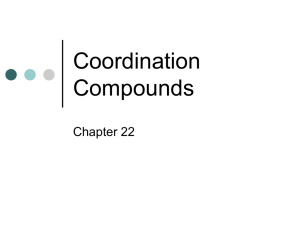
John E. McMurry • Robert C. Fay
General Chemistry: Atoms First
Chapter 20
Transition Elements and Coordination
Chemistry
Lecture Notes
Alan D. Earhart
Southeast Community College • Lincoln, NE
Copyright © 2010 Pearson Prentice Hall, Inc.
Electron Configurations
Chapter 20/2
Electron Configurations
Sc (Z = 21): [Ar] 3d1 4s2
Zn (Z = 30): [Ar] 3d10 4s2
Chapter 20/3
Electron Configurations
Chapter 20/4
Properties of Transition
Elements
Metallic Properties
Properties of Transition
Elements
Atomic Radii
Chapter 20/6
Properties of Transition
Elements
Atomic Radii
Chapter 20/7
Properties of Transition
Elements
Atomic Densities
Chapter 20/8
Properties of Transition
Elements
Ionization Energies and Oxidation Potentials
All but copper are positive.
M(s) + 2H1+(aq)
M2+(aq) + H2(g)
E° > 0 V
Copper requires a stronger oxidizing agent than HCl,
such as HNO3.
Chapter 20/9
Oxidation States of Transition
Elements
Oxidation States of Transition
Elements
Chapter 20/11
Oxidation States of Transition
Elements
For group 8b, the loss or sharing of all the valence electrons
is energetically prohibitive because of the increasing value
of Zeff. Consequently, only lower oxidation states are
accessible. Also, they can sometimes be reduced to even
lower oxidation states:
4Co3+(aq) + 2H2O(l)
4Co2+(aq) + O2(g) + 4H1+(aq)
E° = +0.58 V
Chapter 20/12
Chemistry of Selected
Transition Elements
Chromium
•
Chromium can be obtained by the reduction of the ore
chromite (FeCr2O4) with carbon:
FeCr2O4(s) + 4C(s)
Fe(s) + 2Cr(s) + 4CO(g)
Ferrochrome
Up to 30% Cr
•
Pure chromium is obtained by reducing Cr2O3 with Al:
Cr2O3(s) + 2Al(s)
2Cr(s) + Al2O3(s)
Chapter 20/13
Chemistry of Selected
Transition Elements
Chemistry of Selected
Transition Elements
Chromium
Chemistry of Selected
Transition Elements
Chromium
•
In basic solution, Cr3+ precipitates as Cr(OH)3, a pale
green solid which is amphoteric:
Cr(OH)3(s) + 3H3O1+(l)
Cr3+(aq) + 6H2O(l)
Cr(OH)3(s) + OH1-(aq)
Cr(OH)41-(aq)
Chapter 20/16
Chemistry of Selected
Transition Elements
Chromium
Chemistry of Selected
Transition Elements
Chromium
•
In the +6 oxidation state, the most important solution
species are yellow chromate ion and the orange
dichromate ion:
2CrO42-(aq) + 2H1+(aq)
yellow
•
Cr2O72-(aq) + H2O(l)
orange
The orange dichromate ion is a powerful oxidizing agent
in acidic solution and is widely used as an oxidant in
analytical chemistry:
Cr2O72-(aq) + 14H1+(aq) + 6e-
2Cr3+(aq) + 7H2O(l)
E° = +1.36 V
Chapter 20/18
Chemistry of Selected
Transition Elements
Chemistry of Selected
Transition Elements
Iron
•
In the absence of air, iron metal will react with acids:
Fe(s) + 2H1+(aq)
Fe2+(aq)
•
Fe2+(aq) + H2(g)
E° = +0.45 V
spontaneous
Fe3+(aq) + e-
E° = -0.77 V
nonspontaneous
In the presence of air, Fe2+ is slowly oxidized:
4Fe2+(aq) + O2(g) + 4H1+(aq)
4Fe3+(aq) + 2H2O(l)
E° = +0.46 V
spontaneous
Chapter 20/20
Chemistry of Selected
Transition Elements
Iron
•
The red-brown colored Fe(OH)3 will precipitate in basic
solutions, but unlike the analogous Cr(OH)3, it is not
amphoteric (dissolves in base):
Fe3+(aq) + 3OH1-(aq)
Fe(OH)3(s)
Chapter 20/21
Chemistry of Selected
Transition Elements
Copper
•
Copper sulfides are separated from ores and then hot air
is blown through molten copper(I) sulfide (Cu2S):
Cu2S(l) + O2(g)
•
2Cu(l) + SO2(g)
Over time, copper turns green due to oxidation:
2Cu(s) + O2(g) + CO2(g) + H2O(g)
Cu2(OH)2CO3(s)
Cu2(OH)2CO3(s) + H2SO4(aq)
Cu2(OH)2SO4(s) + CO2(g) + H2O(l)
Green patina
Chapter 20/22
Chemistry of Selected
Transition Elements
Copper
Chapter 20/23
Coordination Compounds
Coordination Compound: A compound in which a
central metal ion or atom is attached to a group of
surrounding molecules or ions by coordinate covalent
bonds.
Ligands: The ions, molecules, or atoms that surround
the central metal ion.
Ligand Donor Atom: The atoms in the ligand that
bond to the central metal ion.
Coordination Number: The number of ligand donor
atoms that surround a central metal ion.
Chapter 20/24
Coordination Compounds
Chapter 20/25
Coordination Compounds
Chapter 20/26
Ligands
Monodentate: One ligand donor atom that surrounds
a central metal ion.
Polydentate: Two or more ligand donor atoms that
surround a central metal ion.
Chapter 20/27
Ligands
Chapter 20/28
Ligands
Chelating Agents: Polydentate ligands. Their multipoint
attachment to a metal ion resembles the grasping of an
object by the claws of a crab.
Ligands
Chapter 20/30
Naming Coordination
Compounds
1. If the compound is a salt, name the cation first and then
the anion, just as in naming simple salts.
Chapter 20/31
Naming Coordination
Compounds
2. In naming a complex ion or a neutral complex, name the
ligands first and then the metal. The names of anionic
ligands end in -o. Neutral ligands are specified by their
usual names except for H2O, NH3, and CO.
Naming Coordination
Compounds
3. If the complex contains more than one ligand of a
particular type, indicate the number with the appropriate
Greek prefix. The ligands are listed in alphabetical order,
and the prefixes are ignored in determining the order.
4. If the name of a ligand itself contains a Greek prefix, then
put the ligand name in parentheses and use one of the
following alternative prefixes to specify the number of
ligands: bis- (2), tris- (3), tetrakis- (4), and so forth.
5. Use a Roman numeral in parentheses immediately
following the name of the metal to indicate the metal’s
oxidation state.
Chapter 20/33
Naming Coordination
Compounds
6. In naming the metal, use the ending -ate if the metal is
an anionic complex. Some anion names are Latin.
Chapter 20/34
Isomers
Chapter 20/35
Isomers
Constitutional Isomers-Linkage Isomers
Isomers
Constitutional Isomers-Ionization Isomers
[Co(NH3)5Br]SO4
A free sulfate ion.
[Co(NH3)5SO4]Br
A free bromide ion.
Chapter 20/37
Isomers
Stereoisomers-Diastereoisomers
adjacent
opposite
Chapter 20/38
Isomers
Stereoisomers-Diastereoisomers
Enantiomers and Molecular
Handedness
Chiral: Objects that have a handedness to them.
Nonidentical mirror images.
Nonchiral: Objects that lack a handedness to them.
Chapter 20/40
Enantiomers and Molecular
Handedness
Enantiomers and Molecular Handedness
Enantiomers and Molecular
Handedness
Chapter 20/43
Color of Transition Metal
Complexes
Chapter 20/44
Color of Transition Metal
Complexes
Color of Transition Metal
Complexes
∆E = E2 - E1 = h =
hc
or
hc
=
∆E
Chapter 20/46
Color of Transition Metal
Complexes
Chapter 20/47
Color of Transition Metal
Complexes
Chapter 20/48
Bonding in Complexes:
Valence Bond Theory
Chapter 20/49
Bonding in Complexes:
Valence Bond Theory
Chapter 20/50
Bonding in Complexes:
Valence Bond Theory
Chapter 20/51
Bonding in Complexes:
Valence Bond Theory
Bonding in Complexes:
Valence Bond Theory
Bonding in Complexes:
Valence Bond Theory
High spin
Low spin
Chapter 20/54
Crystal Field Theory
Crystal Field Theory: A model that views the
bonding in complexes as arising from electrostatic
interactions and considers the effect of the ligand
charges on the energies of the metal ion d orbitals.
Chapter 20/55
Crystal Field Theory
Octahedral Complexes
Crystal Field Theory
Octahedral Complexes
Chapter 20/57
Crystal Field Theory
Octahedral Complexes
[Ti(H2O)6]3+
[Ni(X)6]2+ X=H2O, NH3, and ethylenediamine (en)
Crystal Field Theory
Octahedral Complexes
The crystal field splitting changes according to the
spectrochemical series.
[Ni(X)6]2+ X=H2O, NH3, and ethylenediamine (en)
Crystal Field Theory
Octahedral Complexes
This accounts for the magnetic properties of complexes.
Crystal Field Theory
Tetrahedral and Square Planar Complexes








